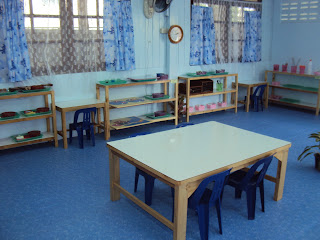 |
| Ground rules cards. |
For many students and teachers, all over the world, this is probably one of the most exciting and busiest time of the year as the school year is coming to an end. It is too for us here in Thailand, except for one different reason: our new school year just begun in May last month!
Managing a Montessori classroom filled with 15 to 35 students - most of them have never been to a school before – is certainly not an easy task to do - but it is crucial to do it right at the very beginning if we want to have a smooth run and peaceful classroom for the entire school year. And establishing the clear classroom ground-rules at the beginning of school year is one of the most important tools that we can use for this purpose.
Although they may vary from class to class, the Montessori ground-rules are basically based on respect for self, others, and the environment while at the same time still give the children freedom to choose and promote the joy of learning and self-discovery. Some of the ground-rules that we use in our classroom are: sit properly during circle time, use walking feet and indoor voice in the classroom, put the material back where it belongs after use, and be kind to our friends. The lessons of Grace and Courtesy, such as how to greet, how to ask teacher for help, or how to observe friend’s work, are given through role plays and discussions in the circle time.
 |
| Looking at the ground rules. |
Having a set of ground rules, of course, doesn’t automatically guarantee a peaceful classroom. Consistency is the key. This is the part where teachers play an important role to help the children internalizing pro-social behavior and achieving self-discipline. One of the mistakes that many teachers make is to think and give the ground-rules lessons only at the beginning of the school year. Ground-rules and Grace and Courtesy lessons are year-long lessons as the children continue to learn to socialize and establish pro-social behaviors. One last thing to remember, actions speak louder than words. One of the most effective ways to promote pro-social behavior in our classroom is by being a good role model for our students.


















